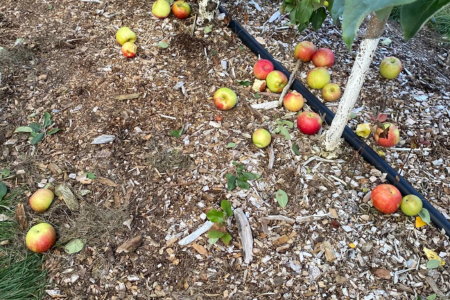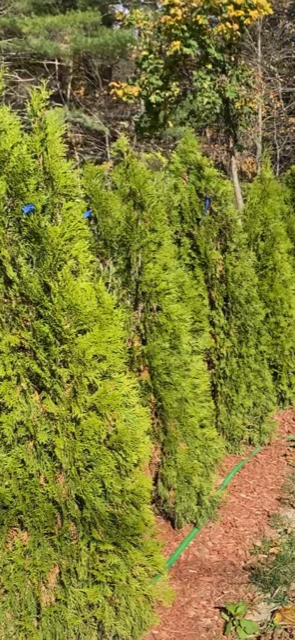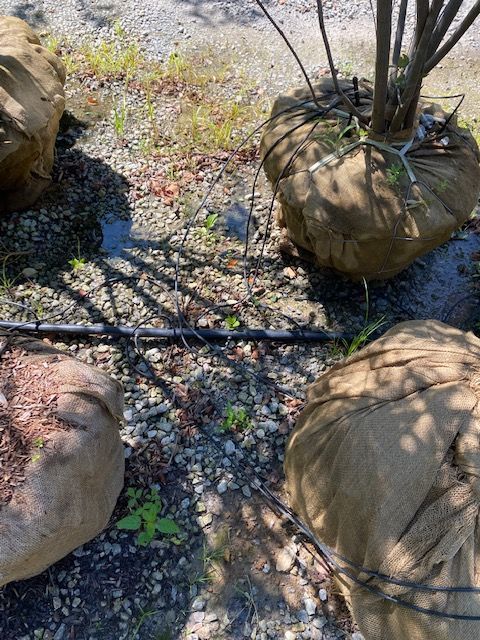How To Hide Drip Irrigation Lines

We test and review gardening and other outdoor products based on an independent, multi-point methodology. If you use or links to purchase something, we may earn a commission. Read our disclosures.
Most people don't know how to hide drip irrigation lines. You get excited to set up your drip irrigation system; then you realize it looks like a wire closet in the IT Department. No bueno.
It can be tricky to do, with varying results depending on the lines, but we will walk you through the quickest and easiest ways to hide your drip irrigation lines.
Let's go.
Hiding Your Drip Irrigation Lines
Before we start, just know this is going to come down to the specific application of your drip lines. Drip irrigation for potted plants will look different than drip irrigation for raised beds.
So just keep that in mind.
Burying Drip Irrigation Lines Underground

The most common way to hide your drip irrigation lines is to bury them underground.
Yes, you can bury drip irrigation lines. Dip up a small trench about 4 to 5 inches deep, and run the line through the trench to your planting area.
Make sure that the drip emitters face up if you decide to bury your drip line. Otherwise, the lines can clog with debris.
Benefits
- Reduced Kinking & Movement:
Drip line buried beneath the soil is exposed to less temperature fluctuations as drip line above the soil. The lines can expand when temperatures get hotter, and then contract again as the temperature drops. The drop in temperature can cause the line to kink which is not ideal. On top of that, all this expansion and contracting can cause the lines to move a bit away from the root zone of the plants. And don't even get me started with wind...
- Sun Damage: If your drip irrigation tubing is just getting cooked in the sun, you can expect it over easy. Ok bad joke. But drip lines typically have water around them as that is the entire purpose of the lines. This water can magnify the sun which can damage the line. In some cases, it can burn directly through the line. Burying the lines helps reduce exposure to the sun which can prevent damage overtime.
- Rodent Damage: Rodents can get to your lines above and below the soil. Sadly. As much as we love our furry neighbors, sometimes they just plain suck. However, if you bury your lines, the theory is that some rodents will be less inclined to chew them. But I've seen it all.
This works wonders because it keeps the drip lines out of direct sun and is much more aesthetically pleasing. On top of that, if you are using drip line or drip tubing, you can run water directly to the root zone of the plants. It's excellent for backyard farms or urban homesteads.
Drawbacks
Seems like a solid fix for most people but there are some issues you need to consider:
- Rodents chewing through the line: If a burrowing rodent like a gopher decides to dig deep and chew through your line, it could be harder to find the leak. It will also be harder to fix the leak because you'll have to dig up the line. Now, you can still have rodents chew your drip line when it isn't buried; it would just be a bit harder to fix if it is buried.
- Line collapse: Too much dirt could collapse an unpressurized line. Before you bury your lines, run the drip irrigation system to pressurize the lines with water. The water will pressurize the line to keep it from collapsing, plus you can do any initial troubleshooting if needed.
- Winterizing your drip irrigation line: If you bury your drip irrigation lines, you still need to winterize them. This will be much more difficult if you don't have an air compressor. So keep it in mind, that if you bury all your drip lines, you will still need to winterize your drip irrigation lines come winter, and it could be much harder or time-consuming.
- Clogging: If you bury your drip lines with the emitters facing down, you risk clogging the drip emitters with dirt or debris. Burying them face up reduces the risk of clogged lines when you shut down the system.
- Air Vent & Vacuum Relief: Drip irrigation lines need to be able to expel any air that builds up in the line. For drip irrigation lines buried beneath the surface, it's critical you install an air relief system.
In general, if you aren't a drip irrigation expert, and you bury your lines, you won't be able to regularly check them for damage or any other issues.
Covering Drip Lines With Mulch

Covering your drip irrigation line with mulch is another option. If your planting area has mulch, than it won't hurt to bury the tubing beneath that mulch. You'll protect your drip lines from direct sun, and make your garden more aesthetically pleasing.
Covering lines with mulch has similar but less exaggerated drawbacks as burying them underground. It would be a lot easier to pull the tubing up if its only under a thin layer of mulch.
Attach Your Drip Irrigation Tubing To Your Beds
If you have raised beds, the best thing you can do with drip irrigation tubing adjacent the beds is to attach them directly to the beds themselves. This is simple and would only involve a few stakes to hold the lines in place.
Now, this doesn't 'hide' your drip irrigation lines but it, at the very least, organizes them. Instead of having lines going everywhere, you have them neatly arranged beneath raised beds. If you have fences, you can run the line along the length of your fence to keep them neat.
How To Hide Irrigation Line To A Potted Plant
This was one of the more 'mad genius' level solutions I found for how to hide irrigation lines to potted plants. Use networking line hiders like Cordmate Wiremold to hide small 1/4" micro tubing to your potted plants.
This task takes some more construction inclined as it involves attaching a cord mate to the side of your house and painting over it.
Now, if you ever need to take the line out of the mold, you might have a hard time doing so once its' caulked to the side of the wall. Personally, I like the next option best for hiding small drip lines.
Furniture & Patio Equipment
If you are running some line up over the patio, the best way to hide it, in my opinion, is to just run the line behind any patio furniture you have like couches or storage containers, etc. You can use stakes to run them tight against the house or the deck, and the lines really don't bother anyone.
Final Say On How To Hide Drip Irrigation Lines

That's pretty much it. The best way to hide your drip irrigation line is to bury it. And if it's a smaller line, like micro tubing for potted plants, then do your best to just keep it of sight.
If both of those options aren't available, the least you can do for your drip lines is keep them organized so they don't give that unsightly appearance.
Hiding Drip Irrigation Lines FAQs
Before you go...
So that's it for my guide on how to hide your drip irrigation lines. Getting those drip irrigation lines out of sight will do wonders for the aesthetics of your garden.
Burying your drip irrigation lines has tons of benefits it seems almost dumb not to do it. But, burying them takes a bit more expertise and knowledge of what your doing that it might be difficult for the average hobby gardener.
Be sure to do your own research, or contact a drip irrigation professional if you are uncertain on which way to go.

Carl Anderson
Carl Anderson is an avid outdoorsman with a keen interest in writing about and reviewing tools. He has over 20 years of writing experience and the only time he isn't feverishly typing away at his computer is when he's outside in nature working on his projects. You can learn more about him here.
Join our community!
Join to receive guides, insights, and the latest gardening deals!
